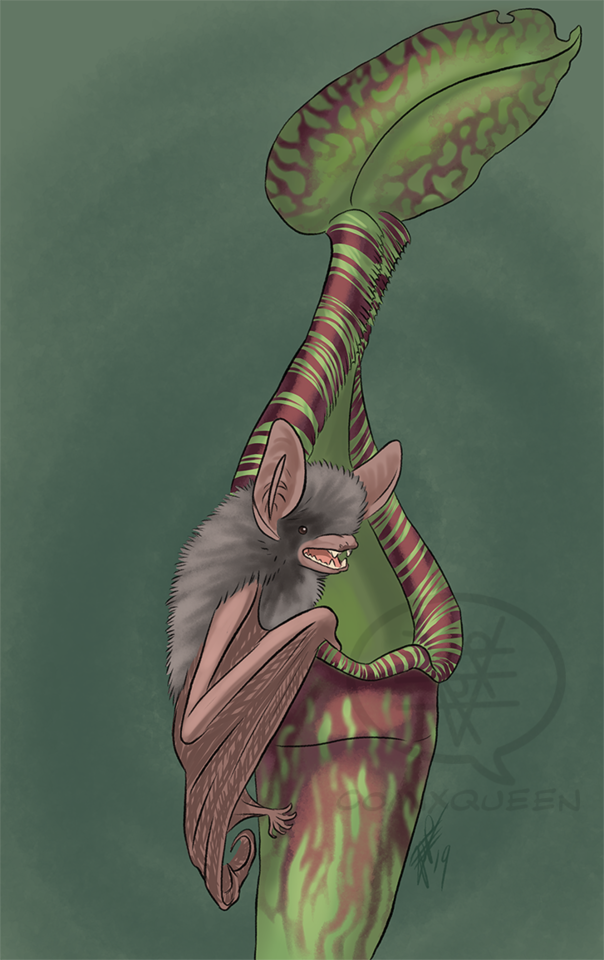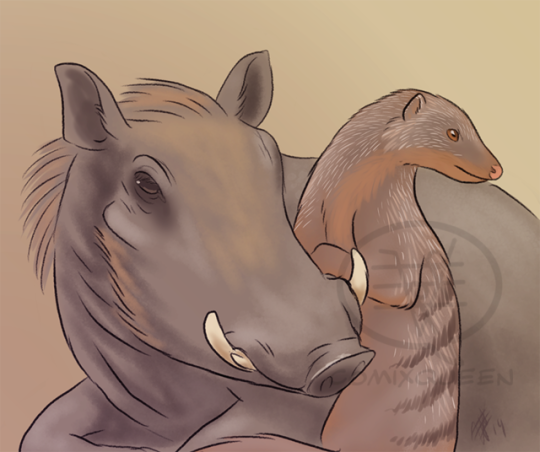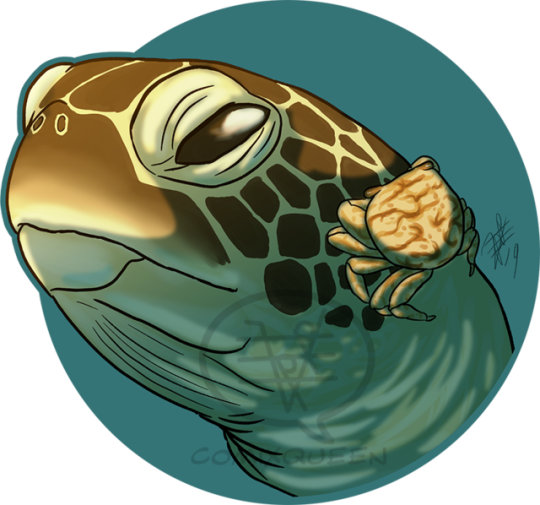#kerivoula hardwickii
Explore tagged Tumblr posts
Text

Hardwicke's Woolly Bat, photographed by Chien C. Lee, (source)
#Hardwicke's Woolly Bat#kerivoula hardwickii#bat#bats#cute bats#daily bats#bats of asia#batposting#chiroptera#microbat#microchiroptera#woolly bat#kerivoula#vesper bat#vespertilionidae#yangochiroptera
179 notes
·
View notes
Text
and as silly as it looks, it’s actually a perfect figure for showing that this carnivorous plant species (Nepenthes hemsleyana) has evolved perfectly to resonate the echolocation of this bat species (Kerivoula hardwickii) so the bat has a safe place to roost :) the plant gets nitrogen and other essential nutrients from its guano :)
Imo this is one of, if not THE, most fascinating plants on the planet. As far as we know, it’s the only plant in the world to evolve to use auditory attractants - quite the feat when you don’t have ears!!
Just saw smth about posting your last saved photo and

I just want y’all to know this is from a real published scientific paper
#or any discernible way of hearing#much like how many female unionid mussels have impressive lures that look like fish without having eyes#like yeah yeah the evolutionary pressure doesn’t come from within I get it#I just think it’s neat!
32 notes
·
View notes
Text
I just finished watching a documentary on Borneo, because giving myself excessive Fernweh during a time when travel isn’t possible is obviously the way to go.
And now I’ve learned about Hardwicke’s woolly bats.
They are tiny and they spend their days sleeping in pitcher plants.



#i was pretty sure the plant wouldn’t be able to eat a whole bat but i still yelled at it#bat and bats#hardwicke’s woolly bats#kerivoula hardwickii#i’d like to be a kerivoula hardwickii in next life please#i think i’d be good at sleeping my days away tucked up in a plant#yes i enthusiastically used a stock photo bc i just have to share them
45 notes
·
View notes
Photo

The mutualistic relationship between Hardwicke’s woolly bats and Nepenthes hemsleyana is quite amazing! I had the privilege of working with Dr. Michael Schoner from the University of Greifswald to create this informational poster to accompany his researcher.
Copyright © 2019 by Holly Sullivan of Sullivan Scientific. All rights reserved.
#scicomm#science#scientific illustration#science illustration#scienceart#sciart#science communication#scienceandart#mutualism#nepenthes#woolly bats#nepenthes hemsleyana#evolutuion#art meets science#hardwicke's woolly bat#kerivoula hardwickii#bats#pitcherplant#natural science illustration#animal science#zoology#zoological illustration#animal science illustration#sullivan scientific
539 notes
·
View notes
Photo

A Hardwicke’s Woolly Bat and an elongated Pitcher Plant. The bats roost in the pitchers and provide nitrogen for the plant when they poop. It is kind of like living in your toilet? I guess? I am very pleased with how this piece turned out! I feel like I “levelled up” on this, especially on the bat’s ear! Detail shot:

#art#science illustration#scientific illustration#hardwicke's woolly bat#kerivoula hardwickii#nepenthes#pitcher plant#nepenthes hemsleyana#nepenthes rafflesiana elongata#bats
3K notes
·
View notes
Photo

“#Baturday this week is featuring Hardwicke’s woolly bat (Kerivoula hardwickii). Most of the bats we’ve featured roost in caves or man-made buildings. Some bats even roost in tree leaves. Hardwicke’s woolly bat, however, roost inside tropical pitcher plants! Yes, you read that right, they roost inside carnivorous plants that usually preys on insects. The specific species of pitcher plant that Hardwicke’s woolly bats, Nepenthes hemsleyana, don’t attract as many insects as other species do, and so it has a positive relationship with the bats. Guano from Hardwicke’s woolly bat provides a large amount of the plant’s nitrogen requirement to survive. Almost 30%! To hold onto the plant’s slippery surface, Hardwicke’s woolly bats have an enlarged pad on their feet, which also prevents damaging the delicate plant tissue. We can find this species in the South and South-East regions of Asia, such as China, Philippines, and Sri Lanka. Hardwicke’s woolly bat is currently listed as least concern with the IUCN, but deforestation is an increasing problem because it decreases the amount of roosts available to the bats. Photo credit: @merlintuttlephoto”
quote and pic from https://www.instagram.com/bat.watch/
29 notes
·
View notes
Photo

🦇Bat Fact! Do you know of Hardwicke’s Wooly Bat (Kerivoula hardwickii)? A species of vesper bat found in Southeast Asia, this insectivorous microbat, weighing less than a US nickel, can be found in forests, lowlands, ridge tops, and more. A slow flyer with high maneuverability, this bat is known for roosting in the carnivorous pitcher plants of the Nepenthes species. The bat and the plant have a mutualistic relationship, with the bat’s feces providing the plant with 1/3 of its foliar nitrogen intake while the plant gives the bat a sheltered, private roost. This bat has enlarged thumb and foot pads which allow it to grip onto the inside of this plant🦇
#batfacts #bats #bat #akhyls #education
📸Photo by Merlin Tuttle/Science Source📸
⬇️Follow Bat Facts⬇️ https://akhylsthebat.tumblr.com/ https://www.minds.com/akhylsthebat/ https://twitter.com/AkhylsBatFacts https://www.facebook.com/groups/137858924078846/ https://t.me/AkhylsBatFacts Disclaimer: All images used here are for educational purposes and are not used in any way for profit or to promote any products or services. Copyright Disclaimer under section 107 of the Copyright Act 1976, allowance is made for “fair use” for purposes such as criticism, comment, news reporting, teaching, scholarship, education and research. Fair use is a use permitted by copyright statute that might otherwise be infringing
4 notes
·
View notes
Text

The venus fly trap does get energy from the sun (otherwise it wouldn’t need to be green/full of chlorophyll aka that green stuff that turns sunlight into energy for plants)
It gets a lot of sunlight. For gardeners growing them, a full 12 hours of sunlight is recommended. What it doesn’t get is soil that is rich in nitrogen and other nutrients. Which is where the bugs come in.
For plants facing the same problem but not choosing violence, look at some species of pitcher plant.
While many pitcher plants do eat insects (or anything else that falls in there) some species partner up with animals instead. For example the Nepenthes hemsleyana of Borneo forgoes the usual pitcher plant features that attract insects (such as UV patterns and bait scents) and instead evolved to be good homes for a species of wooly bat, kerivoula hardwickii which sleep in them

the pitcher plant is shaped in a way that is convenient for the bat to roost in, and keeps its digestive fluid at a really low level, down where it is too thin for the bat to be. Not only that, but they grow their little top leaf thing in a shape specifically to be a good surface for the bats’ echolocation to help the bats locate their sleeping quarters.
In return, the plant digests the nitrogen-rich bat poop left behind each day.
Other pitcher plants team up with shrews and ants and spiders and things in various ways, with some really focusing on just being good toilets

4K notes
·
View notes
Photo



Hardwicke’s Woolly Bat (Kerivoula hardwickii)
Likes to roost in pitcher plants
source: american society of mammalogists, nature picture library, science source,
24 notes
·
View notes
Text
A Poop-Eating Pitcher Plant
The aerial pitchers of Nepenthes hemsleyana (http://bit.ly/2hC94fO) are quite unique in that they are not intended to catch insects. Instead, they have evolved as specialized roosts for Hardwicke's woolly bats (Kerivoula hardwickii). This incredible mutualism is quite unique among these tropical carnivores. The bats get a safe place to roost and in return, they deposit nitrogen-rich feces. This mutualism is quite remarkable in that the upper pitchers of N. hemsleyana have pretty much forgone insect capture altogether. Despite the obvious benefits of this evolutionary relationship, no one had bothered to quantify the benefits gained by turning insect catching pitchers into bat roosts. That is, until now. A team of researchers based out of University of Greifswald in Germany utilized some cunning methods to demonstrate exactly how much N. hemsleyana relies on bat droppings. What they found what quite remarkable. Plants offered only insects not only had fewer leaves, they also exhibited slower growth, reduced photosynthetic capacity, and reduced survival. It would seem that this mutualism has evolved to the point of being obligate. It is estimated that around 95% of the nitrogen needs of this plant are met by bat feces alone. As it turns out, nitrogen bound up in insect tissues were mostly unavailable to the plant. This is not the case for nitrogen in bat poop. Nitrogen deposited by bats comes mostly in the form of urea, which degrades into ammonium and is readily absorbed by the pitchers. Essentially Nepenthes hemsleyana now relies on bats to capture prey for them. This "ecological outsourcing," as it has been termed, frees the plant from the rigors of having to capture and digest insects on its own, thus saving valuable energy reserves that can be allocated to structures such as leaves, stems, and flowers. Why this species has evolved this strategy is anyone's guess. Perhaps it has to do with the deep shaded forest understory in which it grows. Photo Credit: Merlin Tuttle (www.merlintuttle.smugmug.com)
Further Reading: [1]
#Nepenthes hemsleyana#Hardwicke's woolly bat#Kerivoula hardwickii#coprophagous pitcher plants#guano#bats#mutualistic#carnivorous plants#Borneo#Merlin Tuttle
61 notes
·
View notes
Text
people keep messaging me saying that the frog isnt actually being eaten. that’s definitely a possibility but as a big carnivorous plant fan i really feel like i should give my reasoning for being :eyes: at whatever natural interaction is going on here.
yes there are Nepenthes that have mutualistic relationships with various frogs (Microhyla nepenthicola in the very cute and chubby ground-dwelling detritivore species Nepenthes ampullaria), insects (ants in the case of Camponotus schmitzi in Nepenthes bicalcarata), and animals (two separate rat species in Nepenthes lowii, N. rajah, and N. macrophylla, who all share the same borneo habitat; also the cuter example of the tiny, fluffy bat species Kerivoula hardwickii and Nepenthes hemsleyana) but all these are organisms that have adapted to be able to crawl up the inner sides of the pitcher, swim in the acidic pitcher fluid, just generally live in that kind of environment, etc).
i don’t know what species this is and i dont know like, anything about frogs but contrary to the old assertion of pitcher plants (not just asian pitcher plants) only eating insects, there’s been anecdotal evidence for a long time of these plants taking down small animals and reptiles/amphibians, mostly from breeders finding their (captive, greenhouse-bound) plants taking down non-insects when they very much certainly like, Were Not Supposed To Do That. this wasn’t properly demonstrated until last year, when there was a study showing how about one in five plants in a single population of american pitcher plants in canada were found digesting some local baby salamanders when checked. this suggests that pitcher plants of all stripes are opportunistic feeders that will, quite literally, just eat whatever falls in as long as the intentionally slippery lip of the pitcher-- which in the case of Nepenthes is lined with downward-facing hairs and wax crystals that break off if something tries to stick to them -- keeps them there.
of course, that being said, it varies from species to species; a pitcher the size of the one in the pic wouldn’t be able to take down a full sized rat like Nepenthes lowii is known to do when one happens to accidentally fall in, but the frog here...i’m kind of on the fence about it, to be honest. on one hand, it looks like it just might be able to get out, meaning that it really could just be vibing there to take advantage of the free bugs that come by, but on the other hand that pitcher seems to be twice its size, and the wax crystals that line the insides of these pitchers are densest just above where it’s holding its feet.
in conclusion, the frog might be able to get out. it might be just living on the edge, vibing and eating bugs in an extremely risky way. but, if it falls and can’t work it’s way back up to the lip.........hmmmmm

Pacific Chorus Treefrog in a Nepenthes species pitcher! Ashok Khosla.
#Something Happened There. You Hope It Was A Miracle But Probably Not#honestly wish i knew the fate of this frog........a mystery#carnivorous plants#nepenthes#animal death /
3K notes
·
View notes
Photo






The last of my round 1 March Mammal Madness stuff! These were for the Tag Team Division! Twice the animals!
On to Sweet 16!
Featuring: Fork-tailed Drongo and Sociable Weaverbird, Diana Monkey and Red Colobus, Hardwicke’s Wooly Bat and Elongated Pitcher Plant, Warthog and Banded Mongoose, Wattled Jacana and Capybara, Loggerhead Turtle and Columbus Crab.
#science illustration#march mammal madness#2019MMM#fork-tailed drongo#sociable weaverbird#sociable weaver#diana monkey#red colobus#kerivoula hardwickii#nepenthes hemsleyana#Warthog#Banded Mongoose#Wattled Jacana#Capybara#loggerhead turtle#loggerhead sea turtle#pelagic crab#planes minutus#columbus crab
17 notes
·
View notes
Link
#bat biology#bat plants#pitcher plants#Nepenthes hemsleyana#Kerivoula hardwickii#Hardwicke's woolly bat#woolly bat
3 notes
·
View notes
Photo
botanyshitposts:
botanyshitposts:
aphid-kirby:
Me in my house welcoming you with excitement
1.mood
2.fun fact this bat isnt being eaten; like, its roosting there for the night. this is Nepenthes hemsleyana, a pitcher plant species in a mutualistic relationship with the local tiny bat friends Kerivoula hardwickii (Hardwicke’s woolly bat)!! it works like this:
- the pitchers are shaped to make a special distinctive reflection of the bat’s echolocation. so like, the bats can hear where the pitchers are and go to them for roosting.
-the bats enter the pitchers and sit on this special rim inside that holds them above the water line so they dont get eaten on accident.
-up to two teeny bat friends can fit in an average pitcher at a time lmao
-the bat friends poop when they sleep and the plant eats the poop when it falls into the digestive fluid
-bat friends get a safe place to sleep, pitcher plants get food!



IM SORRY FOR REBLOGGING THIS TWICE IN ONE DAY BUT I WAS READING THE STUDY AND IT GOT BETTER

76K notes
·
View notes
Photo
Perfect and adorable.

A Hardwicke’s Woolly Bat and an elongated Pitcher Plant. The bats roost in the pitchers and provide nitrogen for the plant when they poop. It is kind of like living in your toilet? I guess? I am very pleased with how this piece turned out! I feel like I “levelled up” on this, especially on the bat’s ear! Detail shot:

3K notes
·
View notes